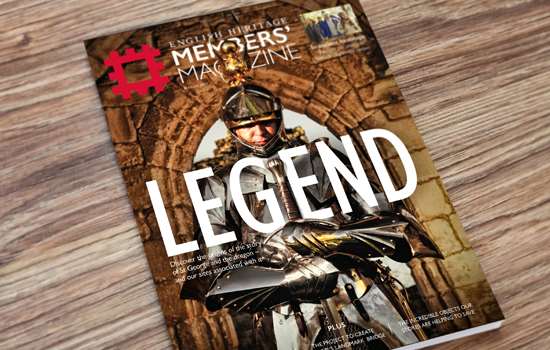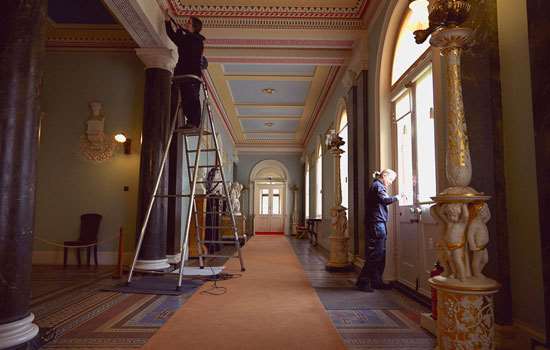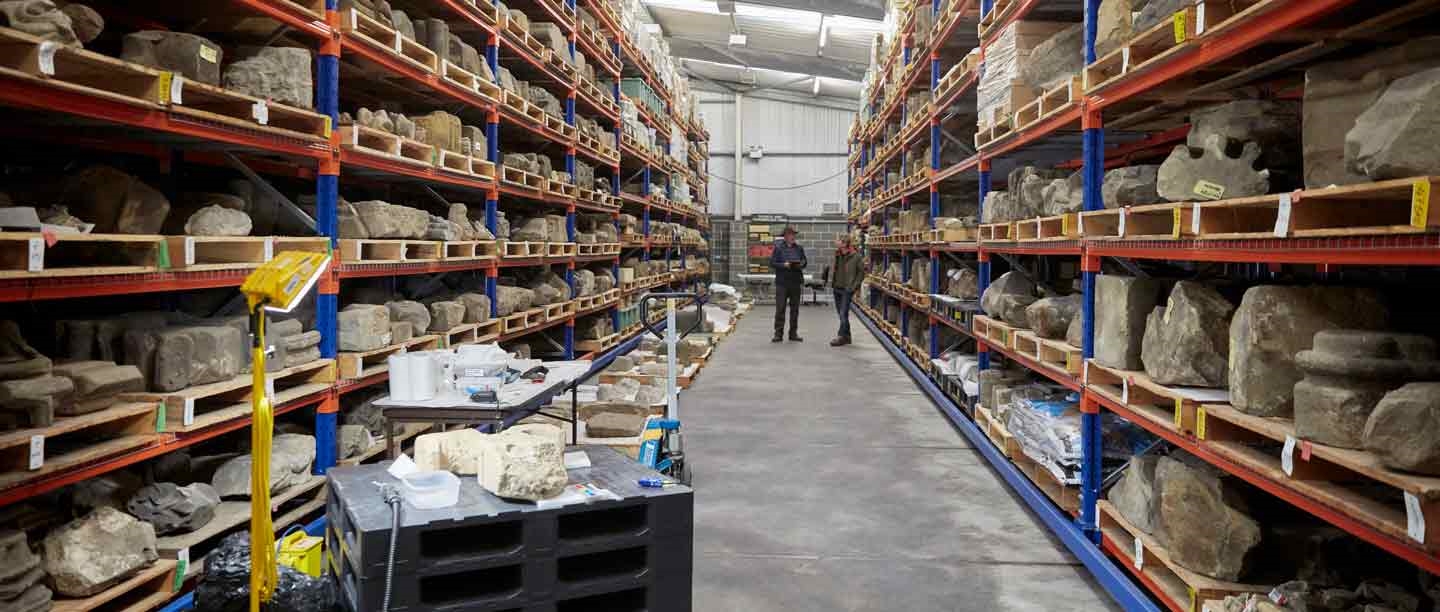Inside the stores
Museum collections are like icebergs. What you actually see is only ever a tiny proportion of what is actually there. Across the country the majority of museums hold the majority of their collections in store and English Heritage is no exception.
This raises lots of questions, possibly the most important being, why keep this material if no one ever engages with it? The fact is that people do engage with it, but perhaps not in a glass case in a gallery environment. It is often the stored objects that provide all of the background knowledge for curators and historians to understand and interpret the landscape properties in our care. It is only ever the star items, those that really help to bring a story to life, which can be displayed.
The vast majority of the collections that English Heritage care for are archaeological in nature. They represent excavation and discovery at our sites going back more than a century. The nature of archaeology is essentially destructive, once you have dug something up it loses its context and so it is vital that you retain as much as possible of what is found to ensure that we can learn from this destructive process. Although we might not display it we can return to the stored collections time and again to ask new questions and, hopefully, get new answers.
In the stores we have a treasure trove that I refer to as the ‘archaeological memory of England’, as well as objects from further afield. Collectively they can inspire us and challenge us to think again about the past and our place in the present.
Matt Thompson, head collections curator
ANCIENT GREEK STATUE (350–250BC)
From: Appuldurcombe House, Isle of Wight
Where it is stored: Fort Brockhurst store
Petrological analysis has revealed this statue of a seated female figure was made of Pentelic marble, which came from quarries around Mount Pentelicus, 16 kilometres north east of Athens and was used for the most important monuments, including the Parthenon. Accession records note its presence among objects owned by Sir Richard Worsley, former owner of Appuldurcombe House. He was a prolific traveller and a well-known collector of fine art and antiquities. I love the fact an ancient Greek statue isn’t an obvious choice of object from an organisation known for promoting England’s story, yet here she is with a clear link to an English Heritage site.
Jade Thompson, documentation officer
COPPER ALLOY DODECAHEDRON (ROMAN)
From: Corbridge Roman Town, Northumberland
Where it is stored: Corbridge Store, Northumberland
This complete example is the most northerly find in the Roman Empire. All of these objects have 12 pentagonal faces, and all have small knobs on the corners. Each face has a circular hole of varying diameters. These items have been puzzling archaeologists since the 18th century, over 50 different theories being published in academic papers alone. One theory was that they were used to knit gloves, the different sized holes being for the different fingers. I love this object because it is a beautiful piece of craftsmanship as well as a complete mystery!
Frances McIntosh, collections curator
BRASS AND LEAD STEELYARD WEIGHT (2ND CENTURY AD)
From: Richborough Roman Fort
Where it is stored: Dover Castle Archaeological Store, Kent
This Roman steelyard is in the form of a bust of the bearded satyr Silenus who was a mythical creature, part man, part goat. Steelyards were used to weigh a range of items including grain, meat, metals, wine and oil. This particular steelyard weight was likely a continental import due to its classical styling and material make-up and, as yet, there are no exact parallels known from Britain.
The Roman’s weighing system was comparatively well-organised but there were local variations throughout the Empire. What is interesting is that this weight has at some point had a large lead alloy lump attached to the base – possibly so it could sit upright for display as a votive figure.
Joanne Gray, collections manager
WHALE VERTEBRA (13TH–16TH CENTURY)
From: Launceston Castle
Where it is stored: Temple Cloud store, Bristol
Many visitors joining us for a behind-the-scenes tour are unsurprised by the boxes of animal bone, but this colossal vertebra always raises eyebrows. Some think it is a dinosaur bone, but in fact it is from a fin whale, which could have measured up to 27m and weighed 100 tonnes.
The big question is why it was discovered at Launceston Castle, one of the most land-locked spots in Cornwall? Deep incisions suggest that it could have been cut from a beached whale and used as a chopping board, but it is also possible that it reveals something of the diet of the privileged classes that inhabited Launceston Castle. Whale was one of the more surprising features of the medieval and early Tudor menu.
Ian Leins, curator of collections and interiors
SEDAN CHAIR (18TH CENTURY)
From: Kenwood, London
Where it is stored: Kenwood, London
This sedan chair, which is part of the Iveagh Bequest at Kenwood, dates from the 18th century and was probably made in France. Sedan chairs were an important mode of transportation throughout the 18th century, when filthy streets littered with mud and refuse made travel difficult.
Named after the town of Sedan in France where they were first used; sedan chairs consist of a seat inside a cabin, which is mounted on two poles carried by two ‘chairmen’; one at the front and one at the rear. While sedan chairs were available for hire in London from 1634, the very wealthy often had their own chairs. Like that at Kenwood, these were often richly carved and decorated and lavishly upholstered.
Louise Cooling, assistant curator
GAME CART (c1909)
From: Brodsworth Hall and Gardens, South Yorkshire
Where it is stored: Brodsworth Hall and Gardens, South Yorkshire
This rare horse-drawn cart was used to collect the pheasants, rabbits and other game at the end of a day’s shooting on the Brodsworth estate. The game was slung over several poles that hung across the width of the cart, and could be extremely heavy. Estate staff recall it being pulled by a strong horse, and sometimes pushed by the keepers as well.
The cart was made in about 1909 by the Bristol Waggon and Carriage Works Company, and was probably used at Brodsworth until the 1950s. You can imagine it trundling around the estate, looking a little like a Wild West wagon – the stories it could tell us if it could only speak!
Eleanor Matthews, curator of collections and interiors
STACK OF DINNER PLATES (1940s)
From: Dover Castle, Kent
Where it is stored: Dover Castle stores (Cold War Collection), Kent
This object gives a disturbing glance into one of humanity's worst moments. The plates were recovered from the wreckage of Hiroshima in 1945 during research into the power and impact of the new atomic bombs.
The glaze on the plates has melted and now the stack is fused together into a single block. Along with tiles that show evidence of boiling (also in store) and other objects, they demonstrate that the temperature at ground zero probably exceeded 3,500ºc for about 3 seconds. The human impact of those conditions is obvious and unsettling. I cannot look at these plates without thinking about what happened to the person who owned them.
Kathryn Bedford, curator of archaeology
DETECTOR HEAD FOR THE AWDREY SYSTEM (1970s)
From: Government stores (of the type installed at York Cold War Bunker)
Where it is stored: Helmsley Archaeological Store, North Yorkshire
The detector head, a black decagon with 10 silicone cells attached to its outface, was designed to register the double flash of a detonating nuclear bomb. When it was designed this technology was indeed the future. Data from the 10 cells fed to a large wheeled cabinet inside the bunker below, where the strength of each pulse, and the gap between them, was used to calculate the power of the explosion, and its approximate direction.
A third element of the system then flicked numbers up on its analogue display, simultaneously spewing a short printed statement – a simple plain scrap of paper – documenting the end of the world.
Kevin Booth, senior curator
Discover More
-

Members' exclusive content
Discover more content exclusively for Members, including videos, downloads and backdated issues of the Members' Magazine.
-

Go behind the scenes
Have a look at what happens during the winter season at Queen Victoria's Isle of Wight holiday home.
-

Find a place to visit
Step into England's story at one of over 400 historic places. Get closer to where history happened, discover our range of epic events and find your next adventure.
